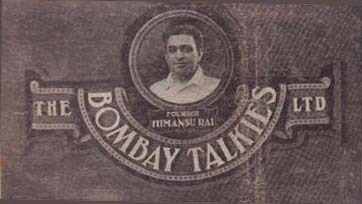Bombay Talkies
Film studio set up by Himanshu Rai in 1934. Among the biggest pre-WW2 talkie studios, it was the only major one launched as a fully fledged corporate body with a board of directors including F.E. Dinshaw, Sir Chimanlal Setalvad, Sir Chunilal Mehta, Sir Pheroze Sethna and Sir Cowasji Jehangir as some of the ‘dozen individuals who, by their control over banks, insurance companies and investment trusts, occupy commanding positions in the industrial life of Bombay’ (A.R. Desai, 1948). It was one of the first studios with backing from major financial institutions, paying a regular dividend from the third year onwards.
The resident star was Devika Rani. The scenarists were Niranjan Pal and J.S. Casshyap. The technical team was imported from Europe, including director Franz Osten, cameraman Josef Wirsching, set designer Carl von Spreti (later Count Carl von Spreti, the West German ambassador murdered in Guatemala in 1970) and soundman Len Hartley. The studio had three major phases. The first, the Rai-Osten era (Achhut Kanya?, 1936; Kangan?, 1939) ended with Osten’s arrest at the beginning of WW2 and, later, Rai’s death (1940). The second saw Devika Rani, as production controller, split the studio into two production groups, one led by Amiya Chakravarty? (best-known film of this period: Jwar Bhata?, 1944, introducing Dilip Kumar) and the other led by S. Mukherjee with Rai Bahadur Chunilal.
It was a high-tech movie studio of its time, with sound and echo-proof stages, laboratories, editing rooms, and a preview theatre. It was the first movie company of India, which was a public limited company and was registered as a company under the Indian Companies Act. Soon, Bombay Talkies emerged as a well organized, self-sufficient, and profitable company, and made public issues, declared dividends and bonus, and at its heyday commanded a good standing on the Bombay Stock Exchange.
On account of its association with European technicians, particularly Germans like Osten, the Bombay Talkies set a high technical standard for film making in India. Bombay Talkies also imparted a higher level of dignity to the medium of movie making and acting. This film company gave some stars to the Indian film industry, including Devika Rani, Ashok Kumar, Leela Chitnis, Madhubala, Dilip Kumar, Raj Kapoor, Mehmood etc. Bombay Talkies also gave a new dimension to themes of films, and produced films on controversial topics like the story of love (Achhut Kanya) between an Untouchable girl and a high caste Hindu Brahmin boy. Other notable movies produced by the Bombay Talkies included famous movies of the period like Jawani ki Hawa (1935), starring Devika Rani, and Jeevan Naiya (1936), a romantic movie starring Devika Rani and Ashok Kumar.
For full movie click here
Studio FILMOGRAPHY (* also d): 1931: Dena Paona; 1932: Mohabbat Ke Aansoo; Chirakumar Sabha; Chandidas; Subah Ka Sitara; Zinda Lash; Punarjanma; Palli Samaj; 1933: Puran Bhakt; Meerabai/Rajrani? Meera; Kapal Kundala; Mastuto Bhai; 1934: Excuse Me, Sir; Rooplekha/Mohabbat? Ki Kasauti; Chandidas; Daku Mansoor; Pear Brothers* (Sh); 1935: Devdas; Dhoop Chhaon/Bhagya? Chakra; Inquilab; 1936: Karodpati; Grihadah/Manzil?; Maya; 1937: Barababu; Anath Ashram; Didi/President?; Bidyapati/Vidyapati?; 1938: Abhigyan/ Abhagin; Street Singer/Saathi?; 1939: Sapurey/Sapera?; Jawani Ki Reet/Parajay?; Rajat Jayanti; 1940: Abhinetri/Haar? Jeet; 1941: Parichay/Lagan?; Pratisruti; 1942: Nari; Saugandh; 1943: Daabi; Wapas; 1944: Udayer Pathey/Hamrahi?; 1945: Vasiyatnama; 1946: Biraj Bou; 1948: Anjangarh; 1949: Bishnupriya; Mantramughda; Swami/Swami? Vivekananda; 1950: Bara Bou; Pehla Admi; 1951: Sparshamani; Paritran; 1952: Maa; 1953: Dard-e-Dil; Shri Chaitanya Mahaprabhu; 1955: Amar Saigal; 1957: Neelachaley Mahaprabhu; 1959: Sagar Sangamey; 1960: Natun Fasal.
Attachments
-
Bombay_Talkies.jpg
 (12.2 KB) -
added by 12 years ago.
(12.2 KB) -
added by 12 years ago.
-
Bombay-Talkies-Studios.jpg
 (95.1 KB) -
added by 12 years ago.
(95.1 KB) -
added by 12 years ago.

